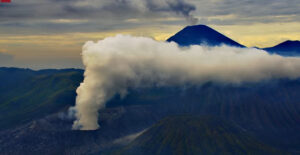The increased activity of two supervolcanoes, one in California and the other in Italy, is worrying residents.
As seismic activity shakes the Long Valley Caldera in California and the Campi Flegrei volcano in Italy, some of those living nearby are preparing their evacuation routes, just in case.
Supervolcanoes have produced some of the largest eruptions in history. There are 20 supervolcanoes on Earth, including the two above. They can displace so much material that they are classed as V8, or colossal eruptions. To put that scale into context, the 1980 Mount St. Helens eruption was a V5. It was 1,000 times smaller than a supervolcano eruption.
Supervolcanoes don’t look like a typical conical volcano. Their previous eruptions were so violent that they created huge depressions in the ground and collapsed in on themselves because they spewed so much of their molten rock into the air.
But the term supervolcano is a little misleading. Volcanoes only have to produce one V8 eruption to earn the supervolcano designation. It doesn’t mean that every one of their eruptions will be of this magnitude.
Thousands of earthquakes
Campi Flegrei has had over 3,450 earthquakes in 2023 so far, and they don’t seem to be slowing. Before May, the eruptions were all below V3 but in the last few months, some have been between V4.0 and V4.2.
Meanwhile, the Long Valley volcano in California — scene of one of the largest eruptions of all time, three-quarters of a million years ago — has had “swarms of earthquakes, as well as the ground inflating…during periods of unrest,” according to the California Institute of Technology.

The northern part of Long Valley Caldera, California, United States. Photo: S.R. Brantley/Wikimedia
Seismic activity can indeed be a sign that a volcano is waking up, but it is not that simple. Researchers at Caltech have been analyzing the earthquakes at Long Valley by creating underground images using seismic waves. Waves from earthquakes travel at different speeds through different materials. Seismometers and fiber optic cables measured over 2,000 earthquakes, many too small for us to notice.
The researchers found that hard, crystallized rock covers the magma chamber and that the volcano is not warming up, it is cooling down. They concluded that the volcano was not heading toward an eruption. Instead, as it cools, the volcano releases some gas and liquid, causing small earthquakes.
In Italy, experts don’t think the earthquakes are a sign that the Campi Flegrei is about to erupt, either. They believe they are happening because of bradyseism, a process where the earth slightly rises and falls as magma chambers fill and empty in a cycle.

Solfatara volcano at Campi Flegrei, Pozzuoli, Naples. Photo: Shutterstock
Prepared for all outcomes
New research suggests that bradyseism is weakening parts of the volcano to the point where the earth’s crust could rupture. But even if this did happen, it does not mean that there would be an eruption.
“Campi Flegrei may settle into a new routine of gently rising and subsiding, as seen at similar volcanoes around the world, or simply return to rest. We can’t yet say for sure what will happen. The important point is to prepare for all outcomes,” said co-author Stefano Carlino.
Experts will continue to monitor the volcanoes.






